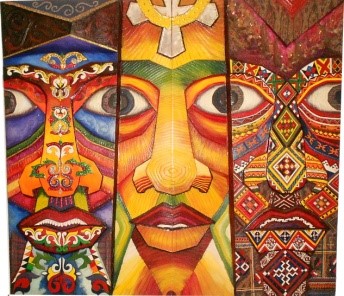Museo Dabawenyo is open again for the public eye since March 14, 2022. The museum is located at Philippine Women’s College – Mindanao Folk Arts Museum and Studies Center (PWC-MFAMSC) along University Ave., Juna Subdivision, Matina, from Monday-Saturday 8:30am-5:30pm. The Museo Dabawenyo’s exhibition at Juna is famous for exhibiting 50 objects narrating from the First Peoples, the Colonial Landscape, Revolution/Resistance and Reconstruction, Resurgence and Reinvention, up to the Current Perspectives and Future Directions. This article will offer you the 50 objects as a point of reference if visiting the museum is not possible.
|| THE FIRST PEOPLES ||
- LUMABAT UG MEBUYAN | This painting shows the concept of life and death in indigenous cosmology. Lumabat rides the tinayok, with his six wives, to the skyworld. Mebuyan creates the underworld where she feeds unborn babies with her several breasts. She takes care of the souls before they reach Gimukodan, the land of dead.

2. DAVAO’S FIRST PEOPLES | Davao City is peopled with the Lumad, the Moro, and the Settlers. The Lumad are comprised of the Ata, Tagabawa, Klata-Guiangan, Ovu-Manuvo, Matigsalug and the Moro people are composed of the Maguindanao, Maranao, Tausug, Sama, Iranun, and Kagan.
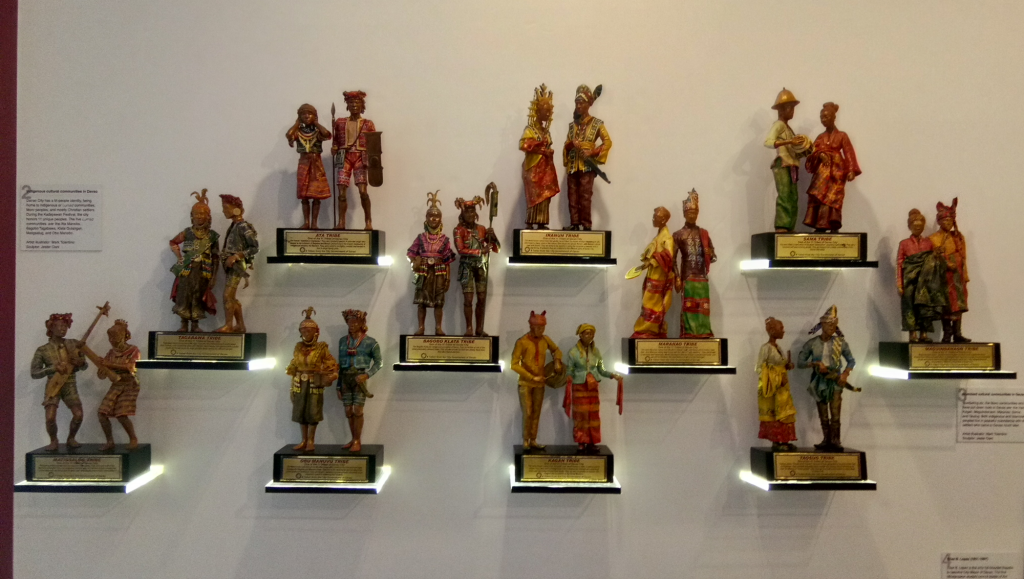
3. ISLAMIZED CULTURAL COMMUNITIES IN DAVAO | Numbering six, the Moro communities who have put down roots in Davao are: the Iranun, Kagan, Maguindanaon, Maranao, Sama, and Tausug. both indigenous and Islamized peoples live in peaceful coexistence with the settlers who came to Davao much later.
4. ELIAS B. LOPEZ | He is the first Bagobo mayor of Davao City and congressman. He established the Datu Bago Awards which recognized individuals who had notable achievements for the development of the city. He created the Kadayawan Festival to celebrate the abundant harvests and the heritage of the indigenous peoples.
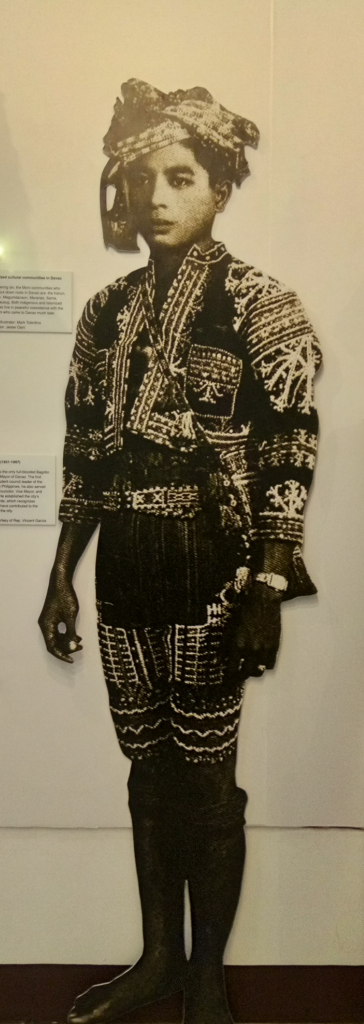
5. TANGKULO | is a textile decorated with sequins and beads worn as headdress. The apo, igbuhag no datu, and bagani wear this in the Ata Manobo community. The warriors of Bukidnon fold this cloth into a three-pointed headdress while the magani of the Bagobo wear this with a blood-red cloth.

6. KABIL | is a small, sling bag from the Bagobo and Manobo communities. Its textile is made from abaca fiber, encrusted with colorful, plastic beads. It is used to carry provisions, especially their betel nut chew, to sustain their long journey. It is believed to be the property of the spirits.

7. AGUNG | The agong is a common percussion instrument among the indigenous communities, used to accompany songs, provide rhythm to dances, and accompany indigenous rituals. The beat of the gong sends news of death, announces emergency, and signifies the time of the day across the villages.

8. BANGKAKAW | The bangkakaw is a log of a dangkalan tree. It is carved out and hollowed at the center to form a rice mortar. Women pound the rice grains with their pestles called ando. The community dances to the women’s rhythmic beat, in thanksgiving to Manama, for the bountiful harvests.

9. PALENDAG | Palendag means lamentation and grief in Maguindanao. The sound of the flute approximates the cry of the bamboo, having been slashed off from the main stalk, symbolizing the wailing of someone who has been cut off from a source and the consequent longing to return home or to one’s beloved.

10. SALUROY | The saluroy/sawroy is a bamboo guitar which accompanies the dances in social gatherings and performances during rites of passages in the community life, especially in performing the aabaka for the abaca harvest, pulutawi (courtship), natarin (dance and chant for someone’s passing), and tagudturan (fast beat dance for male and female).

11. BETEL NUT BOX | This is a storage box for the betel nut chew or nganga. The ingredients of the nganga are laid in its compartments and offered to the guests. Betel nut chewing is vital to social functions, signifying hospitality and allegiance. It is part of a person’s rite of passage.
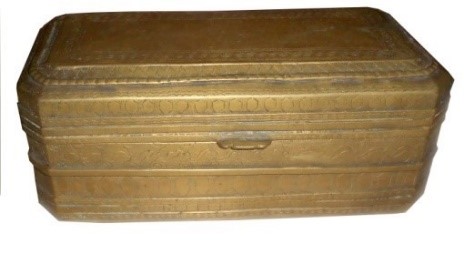
12. GADOR | Brass decor
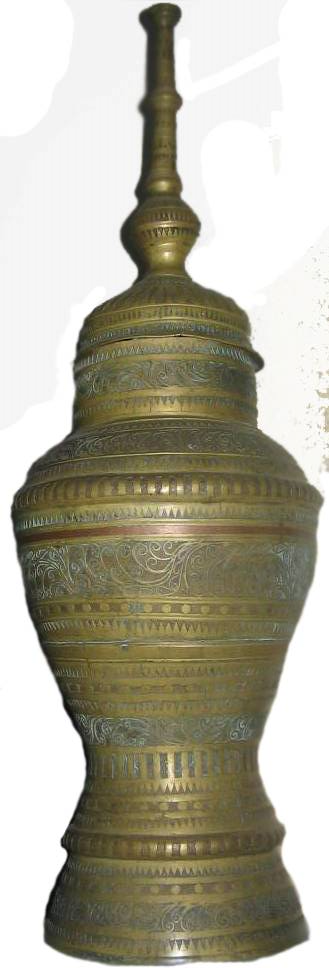
13. TALAM | Talam/tabak is a round platter inlaid with okir swirling patterns. This brass tray is part of a dining set, used as serving tray for food in important social gathering.
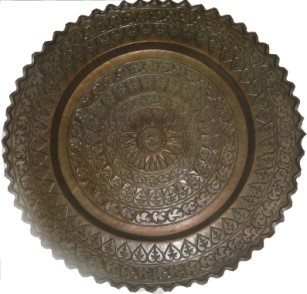
14. SULTAN’S CHAIR | The pre-contact Davao was ruled by sultans, the highest position in indigenous political structure specifically in Islamized cultural communities. This wooden chair is inlaid with metal casted in twirling vine motifs. It symbolizes a seat of power, influence, wealth, leadership, and authority in the land.
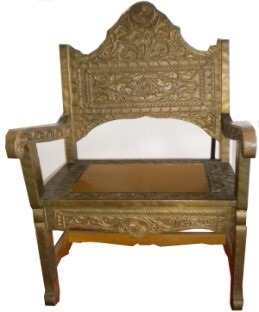
15. BARUNG IN CHEST | Barung is a single-blade sword. Its handle is fashioned after the comb and bill of the cockatoo. The elaborateness of design suggests the social status of the bearer. When the colonizers arrive, Moro community resisted and transformed the barung from a farming tool to a weapon of resistance.

16. KRIS | The kris is a sword of the Moro people. It is distinguishable in its wave-like structure. It is an insignia of rank and leadership and a symbol of high status in the community.
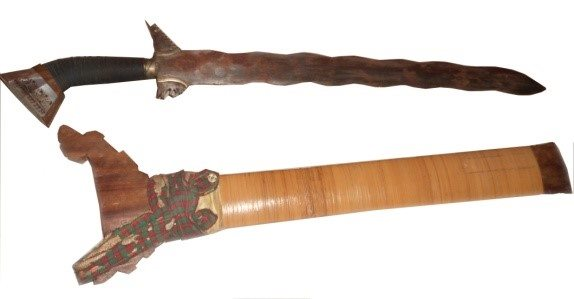
17. DATU BAGO BUST | Datu Bago was the ruling chieftain of Davao Gulf when Jose Oyanguren attacked the last unoccupied territory in the Philippines by the Spanish colonizers in April 1848. Datu Bago heroically defended Davao in a battle that lasted for three months (Tiu, 2013).
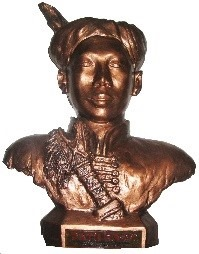
|| THE COLONIAL LANDSCAPE ||
18. OYANGUREN BUST | The Spanish government promised Oyanguren an exclusive trading monopoly around the Davao Gulf for six years should he be able to conquer Davao. Oyanguren attacked with powerful artilleries and ammunition. He defeated Datu Bago. The Lumad and Moro continued their resistance, his exclusive monopoly withdrawn, and died in 1852 (Tiu, 2013).
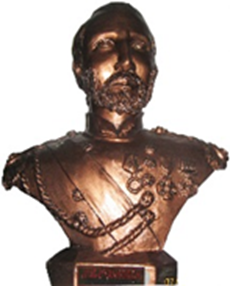
19. MAP OF OLD DAVAO WITH DAVAO RIVER | Map of Davao River and the Town of Vergara (Davao). Dimensions: (101″ x 101″)
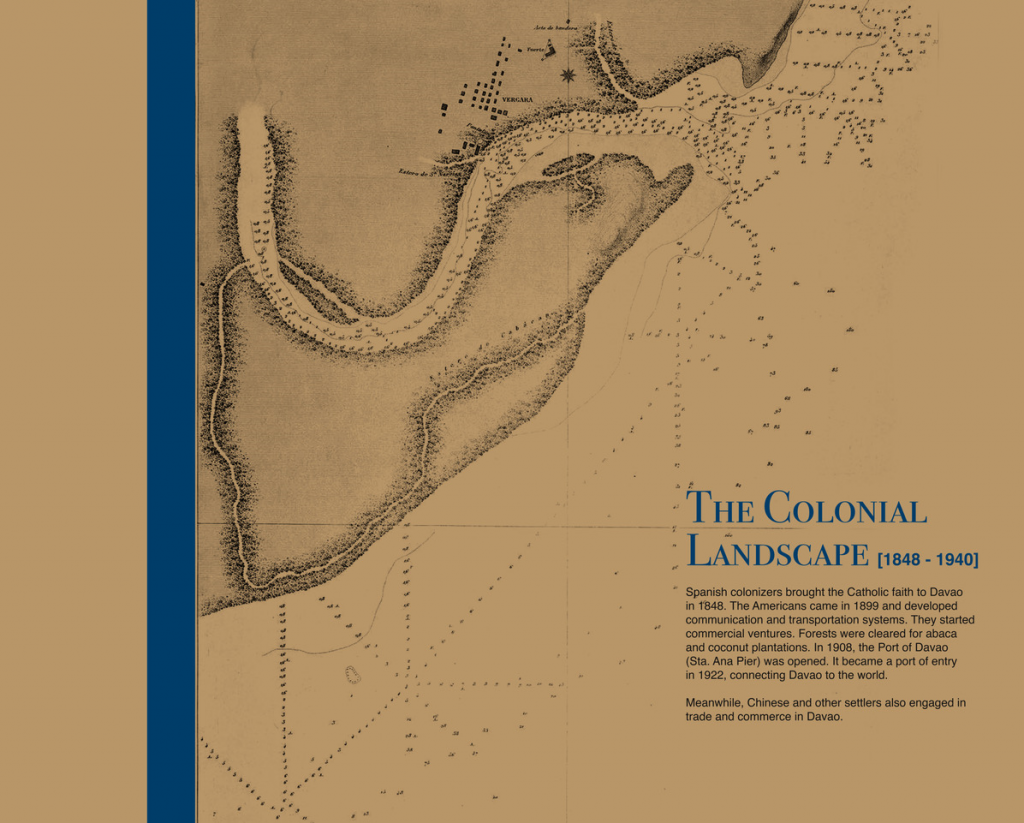
20. CHURCH KNEELER | The Church Kneeler from San Pedro Cathedral is a testament of the penetration of Spanish colonization in Davao. Resistance ensued. Some baptized themselves to evade the Spaniards but continued to practice their Islamic faith, others adapted the religion, and some were converted and knelt to Christianity.
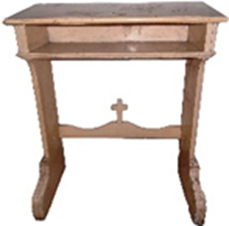
21. OLD BIBLE | This is the Bible used during the Spanish occupation in Davao City.
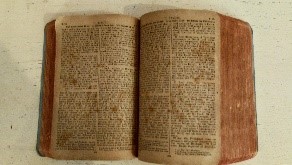
22. STAINED GLASS WINDOW | This stained-glass window shows the series of panels that narrates each mystery in the Four Mysteries of the Holy Rosary. This reflects the Catholic devotion to Mary, the Mother of Christ. Stained glass windows are used to be the windows of the Immaculate Conception Chapel of the Ateneo de Davao University – Jacinto Campus.
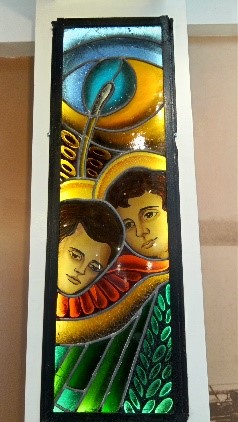
23. FREE STANDING METAL CANDLE HOLDER | This metal candle holder is an item from San Pedro Cathedral. Dimensions: tall, 210cm (H) | Source/Donor: B. Babao.

24. PHOTO OF OLD SAN PEDRO CATHEDRAL | Oyanguren built the San Pedro Church, naming it after St. Peter, whose feast day coincide the defeat of Datu Bago. From nipa, Architect Ramon Basa reconstructed it in wooden Neo-Gothic structure. Architect Manuel Chiew remodeled it in1964, with a boat structure for its roof, symbolizing the life of St. Peter as a fisherman and the Church’s mission to call its flock.
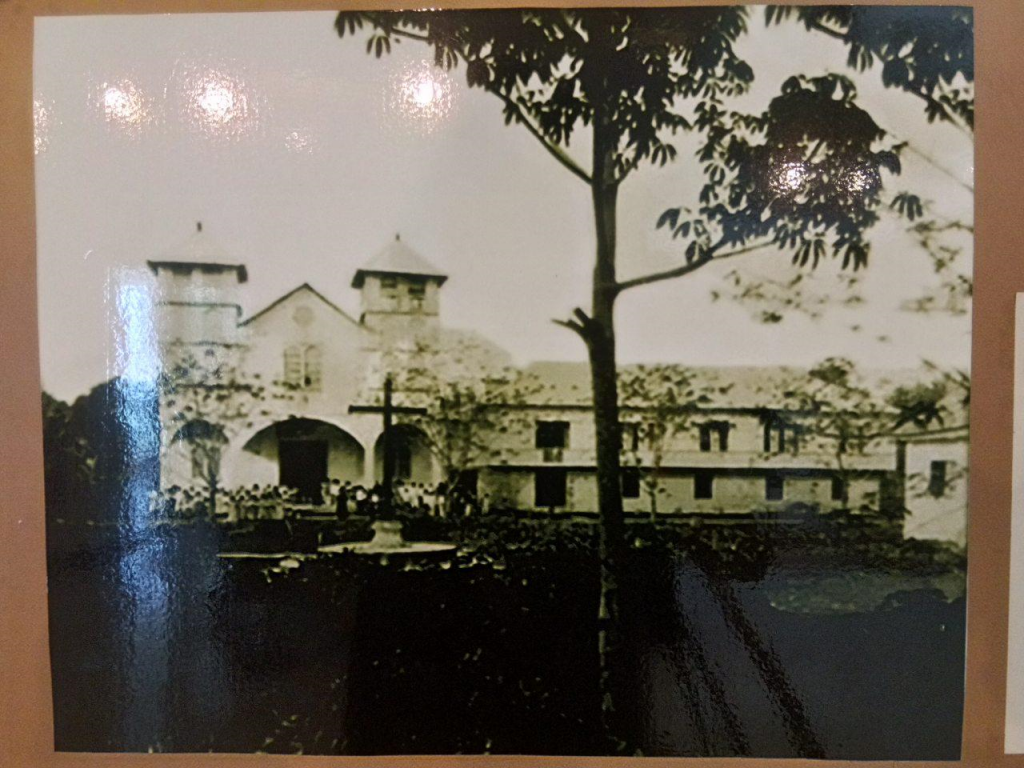
PHOTO OF SANTA ANA PIER | Santa Ana Pier was the center of commerce which connected Davao to the world in 1900s. Aside from the old pier made of wood, the new pier had a P100,000.00 budget around 1925 to be strategically located near the export and warehouses, largely supported by multi-economic sectors and hemp industries.
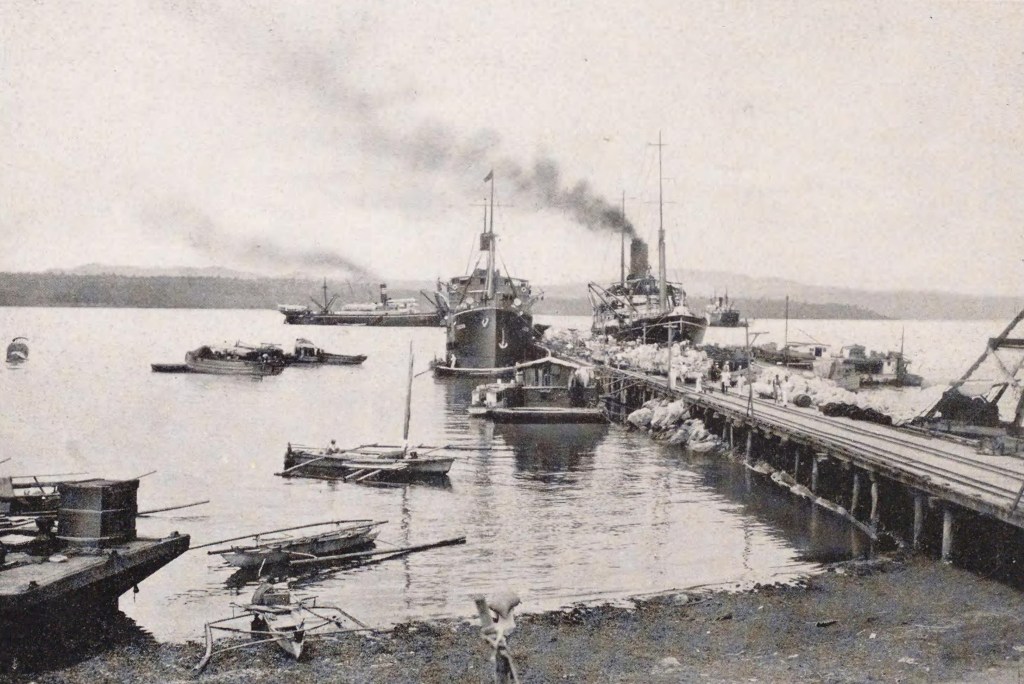
25. CERAMIC PLATE | Chinese started to settle in Davao at around 1850. They brought their cultural materials with them. Among these are ceramic plates, invented by Chinese potters in Tang dynasty. Porcelain and cobalt were combined to create the blue and white ceramic. This is what is known today as “china” ware.
26. BIG CHINESE JAR WITH DRAGON MOTIF | Dragons entwine around the body of this Chinese jar. Dragons are god-like creatures in Chinese mythology. It has the capability to live in waters and rise to the skies to send powerful rain and nurture the crops. It is the symbol of the emperor.
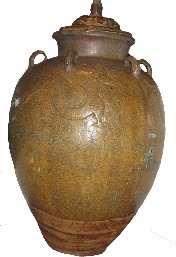
27. ABACUS | When the Japanese and the Americans went back to their countries after suffering the perils of World War II, the era opened for Chinese businessmen in Davao City. They established bakeries, sari-sari stores, retail, milling, shipping, construction business, etc. In 1950s, it became a growing concern that foreigners own the majority of the businesses in the city.
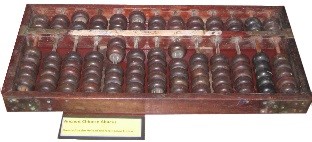
28. DAVAO CHINESE SCHOOL | The Davao Chong Hua High School is the oldest Chinese school in Davao, founded in 1924. It opened on June 3, along San Pedro Street, with two classrooms and 30 pupils.

|| LITTLE TOKYO ||
29. ABACA ROPE | The abaca rope is made from the Manila hemp (Musa textilis), endemic in the Philippines. It was primarily used to make ropes for maritime purposes. Most of the lands in the Davao region were cleared and converted into abaca plantations and large exports were made where three or four steamers arrive in the region carrying the fibers.
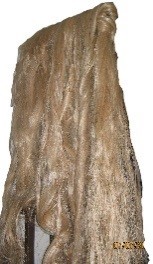
30. STORAGE JAR | Storage Jar, 12.5″ diameter, 20.5″ height
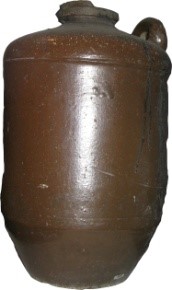
31. ART REPRODUCTION OF RACHEL HOLAZO CITY HALL PAINTING TO REPRESENT 1937 | President Manuel L. Quezon signed Davao into a chartered city in 1937. The City Hall, the seat of power in local government, was once municipal hall built by the Americans in 1926. In 2012, it was declared as a historical site by the National Historical Commission.
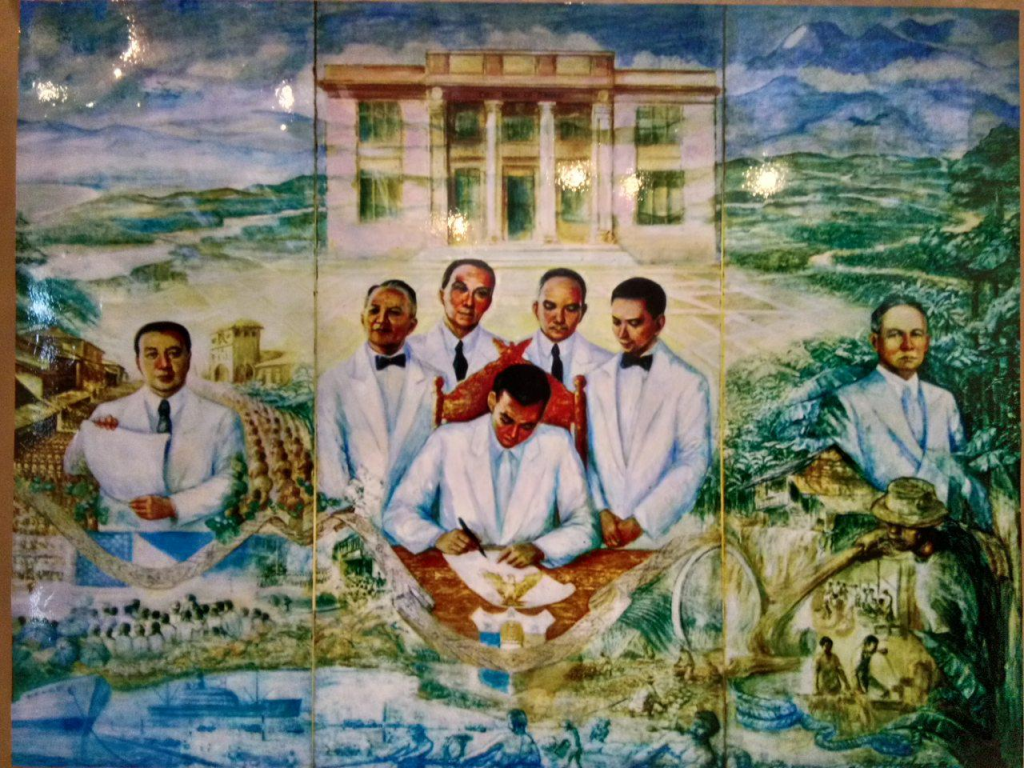
32. TAIL OF JAPANESE NAVY BOMB NO. 90 ORDINARY BOMB MODEL 1 |
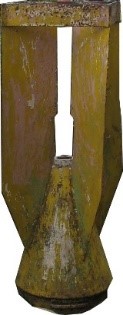
33. SPRINGFIELD SNIPER RIFLE | M1903 Springfield Sniper Rifle issued to the Insular Gov’t. of the Phil. Islands under the United States of America between the period of 1903 to 1941, 102 cm (L)

34. TWO-PERSON CROSSCUT SAW | Two-person crosscut saw, Metal saw for lumber, 7’x 9″.

35. MANUAL TYPEWRITER | The only Japanese newspaper publication in the Philippines is found in Davao City. The local branch of Ker & Company, a subsidiary of Manila-based Underwood Elliott Fisher Sales Agency was the supplier of typewriters.
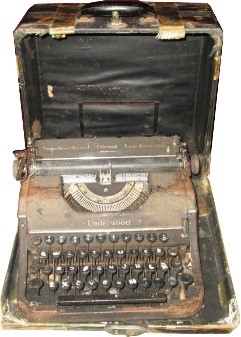
36. FOOT-OPERATED STAPLER | TFoot Operated Stapler, Burroughs Stapler Model No. T-429, SN J1562, 44cm (L) x 39cm (W) x 103cm (H).

37. SEA FAN | This screen is inspired by a tropical soft coral called a sea fan. Award-winning designer Maricris Floirendo Brias mixes and matches abaca fiber with materials, such as wire and coconut beads to create textured home furnishings, such as screens, lamps, ottomans, throw pillows, and wall hangings, among others. Ms. Brias’s creative concepts and innovations have been featured in world exhibits and expositions in Dubai, Germancy, Italy, japan, France and the U.S.

38. FOLIAGE | The chair takes the shape of a leaf abaca or banana, plants that are both significant to the making of Davao. Designer Ann Pamintuan is the first Asian woman to be included in the International Design Yearbook. A self-trained artist, some of her designs cast real flowers, roots, and leaves in gold, silver, and copper. A Datu Bago awardee,s he is also knowns for her cocoon chairs, horse sculptures, and intricate jewelry line.
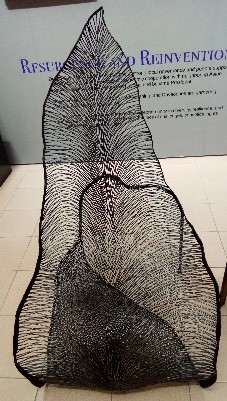
39. MILK CAN, CHEESE PRESSER, AND CHEESE MOLD | Ma. Olivia P. Puentispina once used these implements in her journey as a maker of line artisan cheeses in Davao City. the double-handled metal container stores goat milk collected everyday to be processed into cheese. The cheese presser puts pressure and weight on cheese curds. The holes in the cheese mold allow liquid whey to escape. The cheese mold also gives the cheese curds the space to develop and the shape to take place as it becomes a solid block of cheese. From a single type of cheese in 2005, Olive Puentispina has created the recipes and the production protocol for over 20 kinds of soft and hard cheeses. This is a feat that no Filipino cheesemaker has ever achieved. Malagos farmhouse cheeses are served in more than 90 hotels, resorts, restaurants, and airlines in the country. With her achievement, she has put Davao on the culinary map of the Philippines.
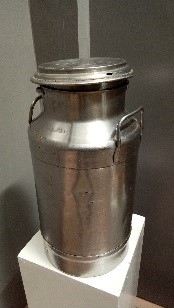
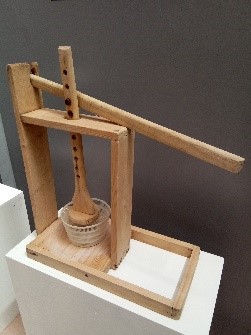
40. ENCANTADA | Agnes Locsin’s first full-length ballet major, Encantada (1992), is set in Spanish colonial Philippines. it references the different “Marias” of Philippine mythology and literature to tell the story of how humanity is destroying our environment and how life begins anew after the deluge. Datu Bago awardee Agnes Locsin is a choreographer and dance maestra who served as artistic director of Ballet Philippines and created masterpieces, such as La Revolucion Filipina, Bagobo, Babaylan, Sayaw Sabel. As artistic director of the homegrown Locsin Dance Workshop, she produced Sayaw Kiu Kok and the Puno series, among others. She is widely acknowledged as having “enriched the canon and language of Philippine dance” with her neo-ethnic creations that are intense, bold, and grounded in ritual and history.
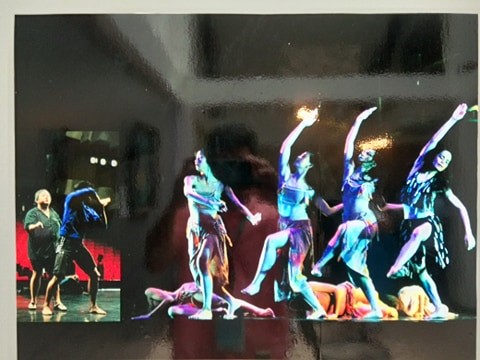
41. MEBUYAN (2008) | The sister of Lumabat refused to join him to travel the heavens. They quarreled. She sat on a big rice mortar, where it spins, sinking and grounding her way below the earth, down to Gimokudan. On her way, she poured the rice grains to the earth and said that the grains represent people who would die and go with her to the underworld. She is named Mebuyan, the chief of Banua Mebuyan, and not simply as Tube ka Lumabat (sister of Lumabat) she was known before. Today, her Banua continues to be the stopover of the spirits. Mebuyan is known to be very ugly for having several breasts where she feeds unborn babies, before they are ready to be weaned off, and eat rice with their dead relatives when they transfer to Gimokudan. Spirits take a bath (pamalugu) at her place so that they can feel at home and will not sneak back to their bodies. In Manobo version, the banua is made of gold where the soul can see its reflection. They can talk only about goodness there and they are listened to. Her abode It is where the soul lives when its physical twin – the body- dies on earth, before finally reaching to Manama, the Supreme Being in Lumad cosmology. Davao City is active in its programs for women and implementation of the Women and Development Code.

42. ROSA MUNDA PAINTING | Rosa Santos Munda is the daughter of General Paulino T. Santos, to whom General Santos City was named after. She graduated from the University of the Philippines College of Education and College of Law. She represented the country in UN Commission on the Status of Women and became a president of the Philippine Women’s University in 1980.

43. STILL LIFE DURIAN (1981) | Davao is the fruit basket of the Philippines and durian is considered as the King of Fruits. Along Magsaysay Park, the durian waft along the fruit stands. The bustling Chinatown welcomes the people through its Arch of Unity and Arch of Friendship at both ends of Magsaysay Street, The Arch of Prosperity, and The Arch of Peace along J.P Laurel and Sta. Ana.
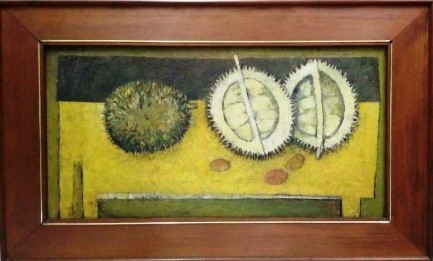
44. ART SCULPTURE OF THE FARMER “MAMUMUO” | Vital to Davao’s life is the farmer who nurtures plants to ensure healthy sustenance. Carved into the sculpture are the face of a tiller with a farming knife, a seeding or a sprout, a plate, and a spoon. Even as investments in technology, communication, and real estate have risen in the city, the agricultural economy is still robust.
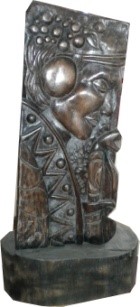
45. CARENDERIA STOOL | When he was city Mayor, Rodrigo Roa Duterte sat on this humble wooden stool for some of his lunches at Sana’s Carenderia–Original kabawan located along Juan Luna extensions, Davao City.

46. THE FIRST FAMILY FROM DAVAO CITY | The Dutertes of Davao City became the Philippines’ First Family when Rodrigo Roa Duterte was sworn in as the 16th President of the Philippines on 16 June 2016. From left: Davao City Acting Mayor Sebastian Z. Duterte, Veronica A. Duterte, President Rodrigo Roa Duterte, Davao City Mayor Sara Z. Duterte Carpio, and Representative Paolo Z. Duterte.
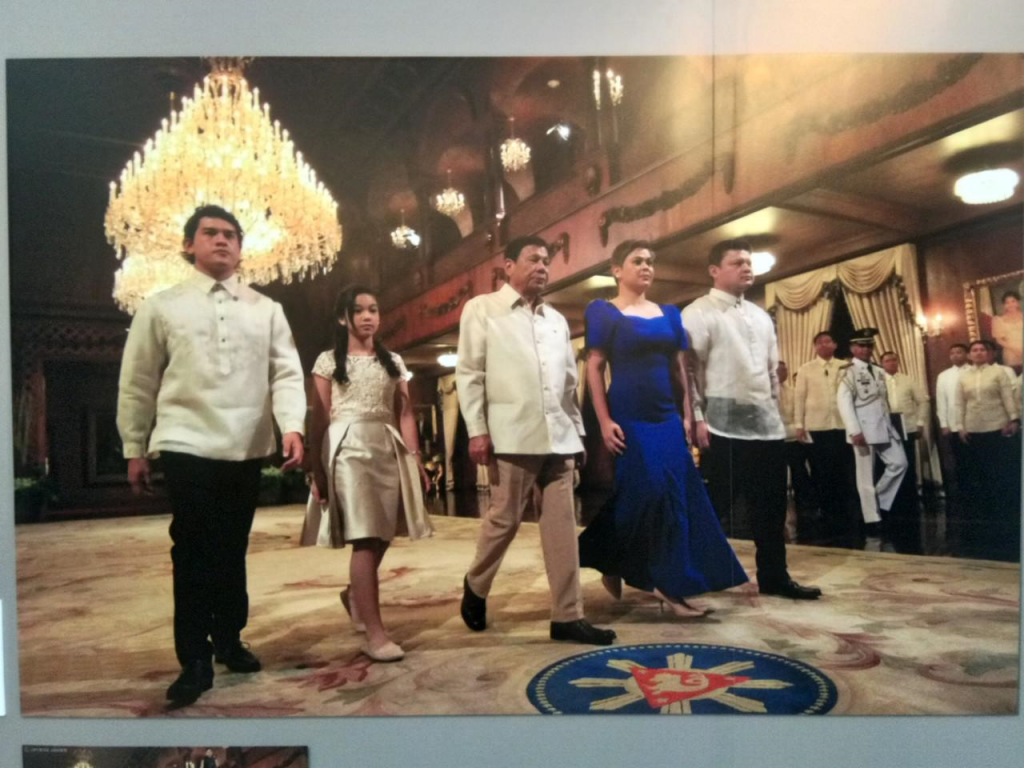
47. THE FIRST FAMILY AS AVENGERS | This meme dresses up the Dutertes as characters from the Marvel cinematic universe From left: Thor, Scarlet withc, Captain America, Black Widow, and Iron Man, Senators Ronald “Bato” dela Rosa and Christopher “Bong” Go appear as “The Hulk” and “Hawkeye”, respectively.
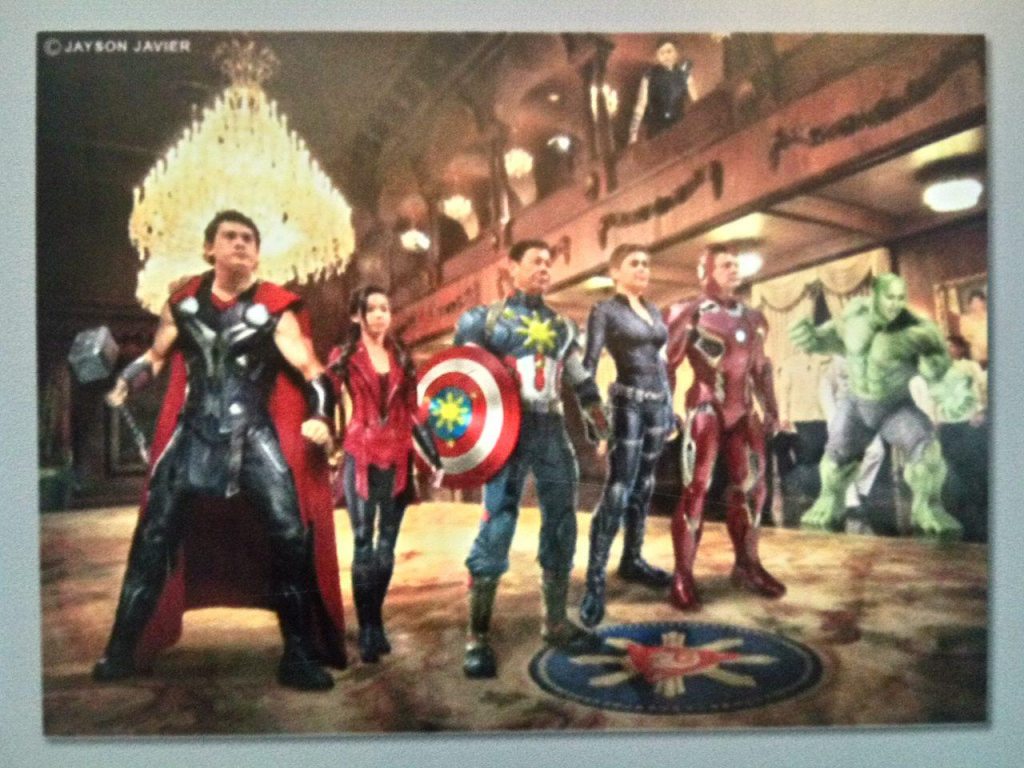
48. OBJECT FROM CENTRAL 911 | The Davao City Central Communications and Emergency Response Center or the Central 911 provides emergency response for medical assistance, search and rescue, fire auxiliary and k-9 services Davao City and its people. It was launched in September 27, 2002 through the collaboration of the Davao Light and Power Company and the City Government of Davao. It strategically links the offices of Davao City Police Office (DCPO), City Transport and Traffic Management Office (CTTMO), Public Safety and Security Command Center (PSSCC), Philippine Coast Guard, among others.
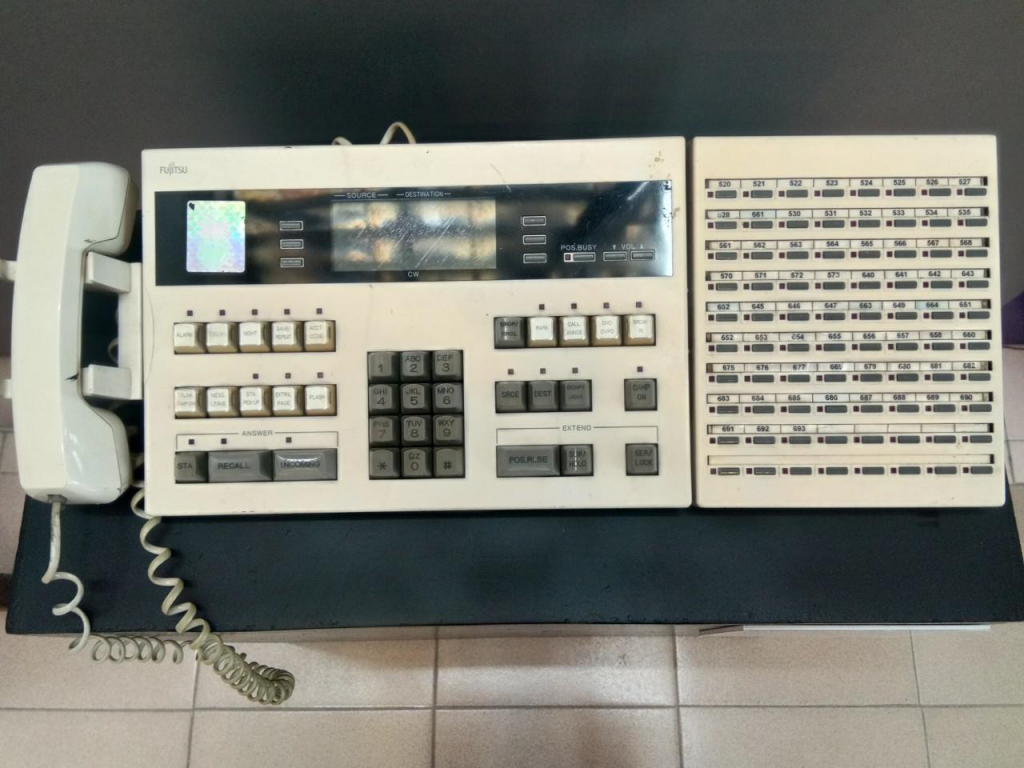
49. KUBLAI MILLAN’S DANCING FOUNTAIN PAINTING | The painting shows a group of children happily playing with the dancing fountains. The artist also sculpted the images of children playing around People’s Park and its fountains. Davao City is known as a child-friendly city.
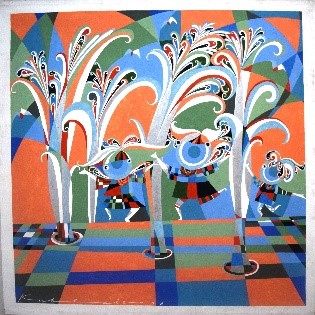
50. TRI-PEOPLE BY BANJO SATORRE | Tri-People presents the Moro, the Settlers, and the Lumad in Davao and Mindanao. The okir – s-curve motifs – swirls on the face of the Moro on the painting, a cross stamps on the forehead representing the Christians, and geometric designs fashion the Lumad’s face. The vibrance of the colors celebrate the festive and abundant harvest in Davao City and its peoples who found unity in diversity.
